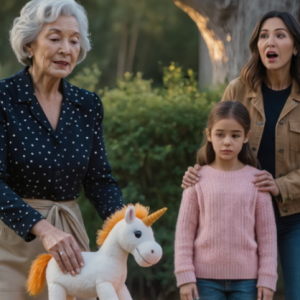
When Nora Bennett first saw the crumbling Halcyon Crest Hotel on the outskirts of Ashton Falls, she wasn’t thinking about profit or prestige. To most people in the small Oregon town, it was just an eyesore—a once-grand landmark now swallowed by ivy and years of neglect. But to Nora, a thirty-seven-year-old single mother barely holding her life together, it felt like a dare from fate.
After her divorce, she and her ten-year-old daughter, June, had been renting a small apartment above a laundromat. The nights were long, the pipes clanged, and the air always smelled faintly of detergent. When the county announced a tax auction for abandoned properties, Nora clicked through the listings more out of curiosity than hope. Mansions, warehouses, burnt-out homes—each one far out of reach. Then she saw it: Halcyon Crest Hotel. Starting bid: $5,200.
“Mom,” June said when she showed her the listing. “That place looks haunted.”
“Maybe it is,” Nora replied with a half-smile. “But maybe it’s waiting for someone crazy enough to care.”
A week later, with a heart pounding so loudly she could barely hear the auctioneer, Nora raised her paddle. No one else bid. Just like that, she became the owner of a twenty-five-room ruin.
The first day she unlocked the double doors, the scent of rot and damp plaster hit her like a wave. Paint peeled from the ceiling in curls, and a family of pigeons scattered from the grand staircase. Yet beneath the decay, there were hints of old glory—marble floors beneath the grime, crystal sconces still clinging to the walls.
June followed close behind, flashlight in hand. “It’s like a castle,” she whispered.
“More like a sleeping giant,” Nora said. “Let’s see if we can wake it up.”
She quickly learned that owning a forgotten hotel was less about romance and more about resilience. Contractors laughed when she asked for quotes. Some told her to tear it down. Money drained faster than she could earn it. She worked double shifts at the diner, painted walls by flashlight, and watched her bank account shrink.
Yet the townspeople began to notice her effort. A retired plumber stopped by one afternoon and offered to fix a few pipes. A group of college students helped clean debris from the ballroom. Even the local paper ran a short story titled “The Woman Who Bought a Dream.”
Still, there was one place in the hotel that unnerved her—the penthouse suite. The door was locked tight, the keyhole rusted over. Every time she passed it, she felt a strange pull, as if the room itself was waiting. Weeks passed before she finally found the courage. Late one rainy evening, she pried the hinges loose with a crowbar. The door gave way with a metallic groan.

Inside, the air was heavy with dust but oddly untouched by decay. Curtains, though faded, still hung from tall arched windows. The furniture was draped in white sheets like sleeping ghosts. In the corner sat an old steamer trunk, iron-bound and massive.
“Can I open it?” June asked, wide-eyed.
“Together,” Nora said.
The lock snapped after a few strikes from the crowbar. Inside were leather folders, rolled canvases, and wooden boxes labeled with an unfamiliar name: A. Montrose. Nora flipped open the first folder. Inside were sketches—portraits, cityscapes, figures rendered in quick, confident strokes.
“These look real,” June whispered.
“They’re… incredible,” Nora murmured. “But who’s Montrose?”
Days of research led to an answer that left her breathless. Arthur Montrose, a British-American painter from the early 1900s, whose few known works hung in museums around the world. If the pieces were authentic, their value could be unimaginable.
Nora called an art appraiser from Portland, a calm, bespectacled man named Simon Caldwell. When he unrolled the first canvas, his voice caught. “You realize what you have here?” he said softly. “These are Montrose originals—unrecorded. This is a historic find.”
For three days, Simon cataloged each piece: forty-two paintings, one hundred and twelve sketches. The estimated worth made Nora dizzy, around $180 million. Somehow, the lost collection of a celebrated artist had been hidden away for decades in a hotel everyone had forgotten.
When the news broke, reporters flooded Ashton Falls. Museums offered exhibitions. Collectors made offers. Nora, overwhelmed but steady, decided not to sell everything. “I want people to see them,” she told Simon. “They’ve been locked away long enough.”
With part of the proceeds, she restored the Halcyon Crest. The marble floors gleamed again, chandeliers sparkled above the ballroom, and the penthouse was turned into a small gallery dedicated to the discovery.
Five years later, on reopening night, guests filled the lobby—artists, journalists, locals who had once called her foolish. Nora stood beneath the grand chandelier, June’s hand in hers, watching laughter and light return to the building.
June looked up at her and smiled. “So… not haunted after all.”
Nora laughed softly. “No, sweetheart. Just waiting to be found.”
For $5,200, she had bought a ruin. But in that ruin, she discovered not just art worth millions—but a story of courage, faith, and the quiet magic of believing when no one else does.




